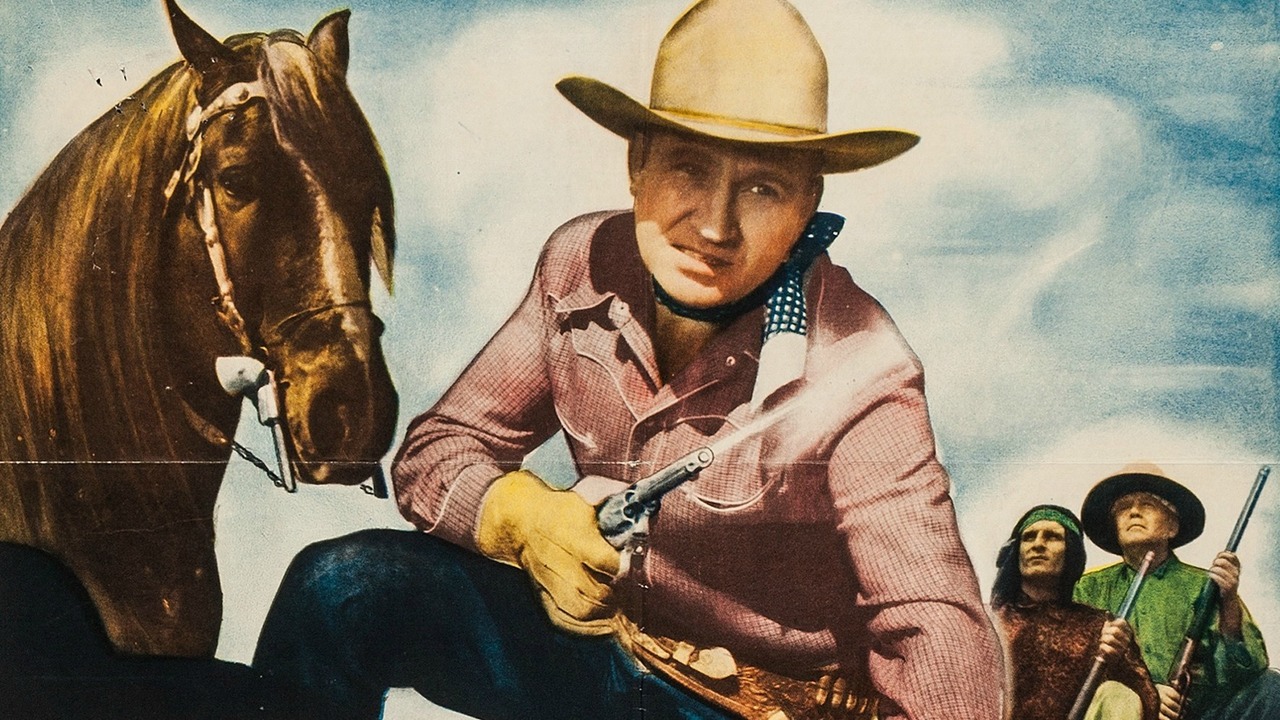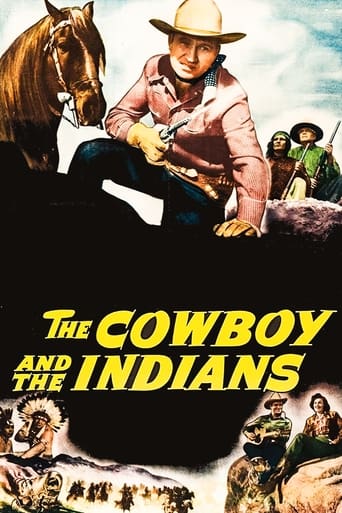

Perfect cast and a good story
... View MoreBy the time the dramatic fireworks start popping off, each one feels earned.
... View MoreBlistering performances.
... View MoreThe movie's not perfect, but it sticks the landing of its message. It was engaging - thrilling at times - and I personally thought it was a great time.
... View MoreI have to admit, I was a bit shocked to hear Gene utter the line in my summary above, but that was before he learned why the local Indian tribe was using his property for grazing land and occasionally taking some of his stock. Apparently they were malnourished and starving, victims of a thieving trading post owner and his band of henchmen. Gene has a quick change of heart and teams up with Jay Silverheels to take down Smiley Martin (Frank Richards) and the rest of his bunch by the time the story's over.For TV and movie Western fans there's a gold nugget of trivia offered here by the casting for the picture. Not only do Silverheels and Clayton Moore both appear in the story, but their own long running series 'The Lone Ranger' debuted on the very same day as this picture's release - September 15th, 1949. For Silverheels, this is not a Tonto style characterization; he portrays a college educated Indian who's also performed military service for his country. Fair to say that Gene was making his own small contribution to Western movie revisionism with this picture in which the villains were white and the Indians actually come riding to the rescue at the end of the picture.After a couple of early songs, one by Gene and another by the Indian school children, I was momentarily perplexed when all of a sudden Gene's on horseback singing 'Here Comes Santa Claus' with Hank Patterson riding alongside in a Santa outfit. That's followed up by the school choir offering a respectful version of 'Silent Night'. I have to say, those kids sounded awful darn good and quite honestly I was looking for a professional choir to be listed in the credits. The picture's worth a look just to hear those youngsters sing.
... View MoreA couple of comments about this film and the lack of a sidekick. Smiley Burnette, although with Columbia at this time could not be used because of still being under contract for the Charles Starrett Durango Kid series as HIS sidekick. Pat Buttram had done an introductory appearance in the Autry film "The Strawberry Roan." He did not start as Autry's sidekick until the film "Riders in the Sky" in 1950. There were several films between Roan and Riders where Autry had no sidekick. Of course, WWII was the reason Burnette signed a long contract for the Durango Kid films with Starrett, Autry having reported for duty in the war. Buttram started on Aurtry's radio show "Melody Ranch" right after the war but apparently was reluctant about appearing in films right away. I think we're all glad he did decide to do so finally and happy that Autry's last 6 films were with original sidekick Smiley Burnette in 1953.
... View MoreI was a bit angered when I read the first User Comment written here by KDWms in April of 2003, and for several reasons. Sure, he or she is entitled to their opinion, and I would never dispute that. And he/she was right about several things in the film. But some of the "facts" listed in that User Comment are just plain wrong. Plus, that writer doesn't seem to know much about the real Gene Autry or the conditions that inspired this movie.I will be using a few of the statements of KDWms in this User Comment. Those words will appear in single quotes(') as I attempt to set the record straight.1. '...this flick contains BOTH Clayton Moore (as a bad guy) AND Jay Silverheels (as a college-educated Indian) BEFORE they were The Lone Ranger and Tonto.'WRONG! If KDWms had bothered to check the facts, he/she would have discovered that the first airing of "The Lone Ranger" Episode #1 and the theatrical release of Autry's "The Cowboy And The Indians" happened ON THE VERY SAME DAY - September 15, 1949. This was an easy one to check - listings for both of them appear right here on IMDb.com. He/she was right about the characters they played in this film. After seeing The Lone Ranger for years, Jay Silverheels' performance here is quite striking. He played his character, a man with an engineering degree and a decorated former GI, with no trace of a "Hollywood" Indian accent - none of that phony "Keemosabe" stuff here.2. '...this film must have been released near Christmas 'cause - get ready for a couple of song-standards of that season toward it's end.'WRONG AGAIN!! Check that September release date one more time. The song, "Here Comes Santa Claus", featured toward the end of the film, was a certified platinum hit record for Gene Autry two years earlier - in 1947 - NOT in 1949 when this film was released. Come on, KDWms. Do your homework.3. 'Aha!!! I know what's missing: the sidekick. Minimal comic relief.'Okay. If that's what you're after, that's fine - there was indeed no Smiley Burnette or Pat Buttram in this film, which there could easily have been. After all, though the picture was distributed by Columbia, it was produced by Gene Autry Productions, so Gene could have done anything he wanted with it. He did just that, including the minimum of comic relief and lack of a sidekick. And unlike most "Cowboys and Indians"-type Westerns, it's not the Cavalry that rides to the rescue in the nick of time - it's the Indians! But I believe Gene wanted to make a point with this film. Come to think of it, you seldom see marauding bands of "wild" Indians in any Gene Autry movie. Not never, but seldom.My guess is there is an important reason there's not much comic relief in this film, unlike any of the Autry films which co-starred either Burnette or Buttram. The truth behind this fictional story is not the least bit funny. Native Americans WERE starving on the reservation in 1949, and many still are today. This concerned Gene Autry greatly during his lifetime. The REAL Autry, as well as the movie Autry, was always concerned about Native American history, poverty and other issues. Notice too, that in his other films and his TV show, Autry included people of ALL races and generally treated them as equals, which was unusual in any Hollywood movie of the period. And the Bosses of the Bad Guys were white in Autry movies. Autry wasn't afraid to put his money where his mouth was. His concerns that people should know the real history of the West were why he sold his extremely profitable Los Angeles TV station, KTLA, in 1981 in order to raise the money to build The Autry Museum of Western Heritage. It was never a shrine to Autry movies nor was it intended to be. Instead it is dedicated to REAL Western history, and is now called The Museum Of The American West. The Autry National Center, the Museum's parent organization, now operates three entities: The Museum Of The American West, The Institute for the Study of the American West and The Southwest Museum of The American Indian, all located in the Los Angeles area. You can learn more about the museums at www.GeneAutry.com. Gene wanted people to learn about the history of Cowboys, settlers and Indians...the REAL way they lived, and not as they were portrayed in standard Hollywood fare. Hence the exploitation of the Native American people depicted in "The Cowboy And The Indians", which is not the sort of thing you'd see in any movie made in 1949, and in only a few since. Now that you know the truth, the next time you see "The Cowboy And The Indians", you just might cry. And it's why I would call this one of Gene Autry's better films, and anything but 'substandard'.
... View MoreI've seen a number of Gene Autry movies and, in my opinion, this is NOT one of the better. Maybe I'm just becoming too negative. Aha!!! I know what's missing: the sidekick. Minimal comic relief. Then there're those stereotypically-wrong characteristics of the Indians. (I know...portrayals were very different in 1949.) At least they're not the villains here. Quite the contrary: this shows how they were victimized in yet another way. At first, Gene is upset by their raids, but he later learns why, which is then still unbeknownst to the local constabulary. So, for awhile there, Gene's on the outs with the law. Interestingly, this flick contains BOTH Clayton Moore (as a bad guy) AND Jay Silverheels (as a college-educated Indian) BEFORE they were The Lone Ranger and Tonto. Also, this film must have been released near Christmas 'cause - get ready for a couple of song-standards of that season toward it's end. Some other tunes were a little TOO hokey and juvenile for my tastes, even taking into account the behavior of the era.
... View More